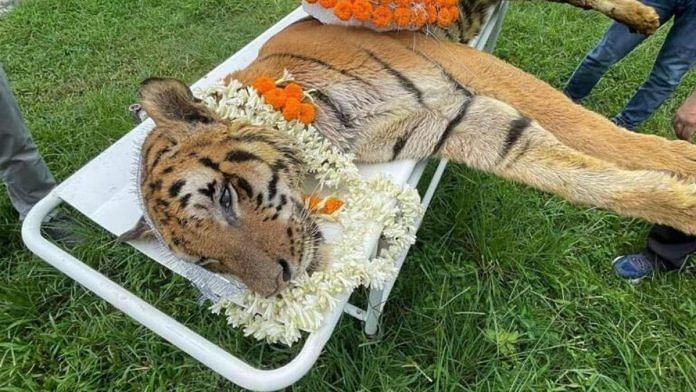Kolkata: From lording over the Sundarbans to fighting crocodiles and terrorising leopards, Raja’s life burned bright and furious. But the oldest Royal Bengal tiger in captivity died on Monday at the age of 25 years and 10 months, leaving behind a legacy of survival and adaptation.
“Everyone was scared of Raja because of how majestic he was. Even the leopards in the adjoining enclosure wouldn’t eat for days when Raja roared. But for me, Raja was happiest while having a bath. He came from the jungle, and his love for water was unparalleled. He would bathe 4-5 times a day,” said wildlife guard and Partha Sarthi Sinha, who took care of him.
Saddened to know that Raja, the oldest living tiger in the world in captivity, is no more.
As the pride of India that lived for over 25 years, Raja will be sorely missed. pic.twitter.com/Fzat3ilrxG
— Bhupender Yadav (@byadavbjp) July 11, 2022
Also Read: How Bachchan, Kipling and Disney made future of tiger uncertain in India
Arrival at the rescue centre
In May 2008, while crossing the River Matla in the Sundarbans, Raja got into a territorial fight with a crocodile and lost a portion of his left hind leg. He was rushed to Kolkata’s Alipore Zoo, where he was treated and christened Raja. Three months later, he was relocated to South Khairbari Rescue Centre.
He had as many as 16 wounds that had yet to heal and was unable to walk when he first reached the rehabilitation centre. Dr Pralay Mandal and Sinha took care of him. “Raja couldn’t run. Every time he tried, he would fall. I used to get tears in my eyes looking at him trying to fight back,” said Sinha.
The rehabilitation centre had 19 tigers when Raja arrived. As months passed, few died and others were picked by zoos, but Raja remained as the king of South Khairbari Rescue Centre.

From the freedom of the wild to life in rehab with limited movement—it was a huge change for the big cat, who according to Sinha, hated people. “He would sit inside his enclosure and not come out till I came to him with his food.”
Raja’s diet comprised 8 kg of beef every day, except Thursdays, when he would fast. It took him nine months to gather the strength to stand up again. It wouldn’t be possible though without the dedicated forest officials who were always by his side. “The first winter was tough. He had come from the Sundarbans, which wasn’t as cold as up here in North Bengal. I would sit by him all night and light firewood. It took him three winters to get acclimatised,” Sinha added.
Monsoons were also bad. There was always a chance of maggots infesting his injured leg. But his caretakers would clean and bandage it every day.
The bond between Raja and Sinha deepened over the years. “The only regret I will have till my last breath is I didn’t get to see Raja before his final journey.” He has been undergoing training since May and was away from the tiger when Raja died.
Also Read: Indian forests out of space for more tigers. What will tiger lobby do now?
Lessons from Raja’s life
Wildlife expert, Col (Retd) Shakti Banerjee, said that while Raja’s survival was “surely marvelous,” it should encourage the forest department to protect the animals in their natural habitat instead of closed spaces.
“You see, Raja was being looked after in a protected space, which means he was being fed on time. He had a caretaker; if he was unwell, a veterinarian would check on him. But the real challenge that we face is to ensure tigers survive in their natural habitat. Though the number of tigers in the country is looking up, their habitat needs to be protected with utmost priority,” said Banerjee, who is also an Honorary Director of the Wildlife Protection Society of India.

According to former IFS officer Ravi Kant Sinha who was the Chief Wildlife Warden of West Bengal, a tiger in the wild can survive anywhere between 11-18 years because as he grows old, he can’t hunt for survival. He, too, underscored the importance of habitat conservation. “We are losing natural habitats very quickly. Reviving wild habitats for animals is a big challenge,” said officer Sinha.
The Sundarban region of West Bengal has been notorious for incidents of man-animal conflicts in the past few years. But Sinha insists that there are two sides to the conflict. “In the last 50 years, there have been no incidents where a tiger has gone outside the forest area to kill a human. Every time someone has been killed by a tiger, it’s because they were in the tiger habitat,” he said.
Wildlife experts hope that Raja’s life will inspire a more concerted effort to save depleting wildlife habitats.
(Edited by Srinjoy Dey)



